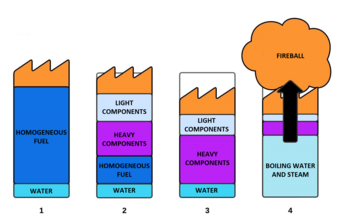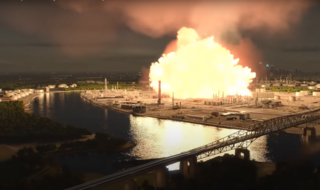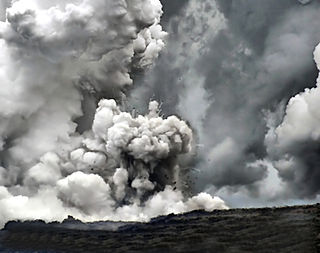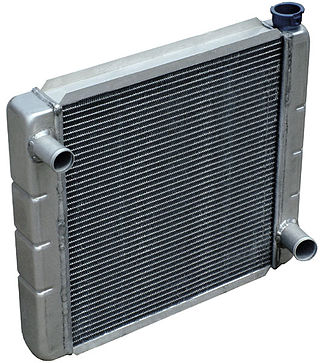Features

The extreme violence of boilovers is due to the expansion of water from liquid to steam, which is by a factor of 1500 or more. [3] In practical storage scenarios, the presence of water under the burning fluid is sometimes due to spurious accumulation during plant operation (e.g., rainwater entering a seam in the tank roof, off-specification products from the source, residual water from an oil reservoir, or humidity condensation) or as a consequence of attempts to extinguish the fire with water. [4] A typical scenario for a tank fire that may eventually result in boilover is an initial confined explosion blowing off the tank roof. [5]
Pure chemical species are not liable to boilover. In order for one to occur, the material must be a mixture of species with sufficiently diverse boiling points. Crude oil and some commercial hydrocarbon mixtures, such as kerosene and some diesel oils, are examples of such materials. [2] The fact that these are stored in large atmospheric tanks in refineries, tank farms, power stations, etc. makes boilover a hazard of interest in terms of process safety. [6] [7] During a pool fire, a distillation process takes place in the fuel. Separation of light components from heavier ones occurs thanks to convective fluid motion. An intermediate fuel layer, called the hot zone or heat wave, is formed, which becomes progressively richer in higher-boiling-point species. Its temperature, as well as thickness, progressively increase. Its lower boundary moves downwards towards the fuel–water interface at a speed higher than the overall level of fuel decreases due to the fire burning it. As a result, when the hot zone reaches the water layer, a considerable amount of unburnt fuel may still be present above the water. Upon the water contacting the hot zone, some steam forms. The resulting turbulence promotes mixing of the water into the hot fuel. This can result in rapid water vaporization. The violent expansion of the steam bubbles will push out a significant part of the fuel above it, causing a violent overflow of flaming liquid. [5] In these conditions water may be superheated, in which case part of it goes through an explosive boiling with homogeneous nucleation of steam. When this happens, the abruptness of the expansion further enhances the expulsion of blazing fuel. [8] [9] [10] Typical hot-zone speeds are 0.3–0.5 meters per hour (1.0–1.7 ft/h), although speeds of up to 1.2 meters per hour (4.0 ft/h) have been recorded. [11]
Apart from the presence of a water layer under the fuel, other conditions must be met for a hot-zone boilover to occur:
- Since the upper fuel layers, including the hot zone, are at or near their boiling temperature, it is necessary for the boiling point of the fuel to be high enough, such that the hot zone temperature is higher than the water boiling temperature. Both the effect of the static head of fuel above the water and the fact that the hot zone composition is different from that of the initial fuel have to be considered. In general, boilover is possible if the fuel mean boiling point (calculated as a geometric mean of its lower and upper boiling points, i.e. the temperatures at which the mixture, respectively, starts to boil and is completely vaporized) is higher than 120 °C (248 °F): [11]
- As mentioned above, the composition of the fuel mixture must be sufficiently varied. It has been observed that the gap between Tboil,max and the higher value between Tboil,min and the boiling point of water at the fuel–water interface has to be higher than 60 °C (108 °F): [12] Some sources indicate that the upper range of the boiling temperature has to be above 149 °C (300 °F): [13] [14]
- The fuel viscosity must be sufficiently high to oppose the upwards movement of the steam bubbles. Otherwise, these may flow through the fuel without projecting it out of the blazing tank. [4] Low viscosity may also make it difficult for a stable heavy-components hot zone to form, thanks to more efficient natural convection. Thus, experiments on gasoline (dynamic viscosity ≈ 0.37 cSt) pool fires have shown that boilover does not occur. [15] In general, fuel dynamic viscosity has to be higher at least 0.73 cSt, which is the viscosity of kerosene. [11]
The hazards posed by a hot-zone boilover are significant for several reasons. At industrial scale, hydrocarbon tanks can contain up to hundreds of thousands of barrels of fluid. If a boilover occurs, the amount of blazing liquid erupting from the tank can therefore be huge. [16] [17] Ejected blazing fluids can travel at speeds up to 32 kilometres per hour (20 mph) [14] and attain distances well in excess of the limits of secondary containment bunding, often hundreds of meters or in the order of ten tank diameters downwind. [16] [17] Bunding, however, remains an important measure to reduce fire spread. [18] Moreover, since boilover inception is sometimes unpredictable —either in terms of time to onset or whether it will occur at all (because the presence of water in the tank bottom may not be a known factor)— the impact on the firefighters that have intervened to control the fire can be deadly. In some cases, simple bystanders were caught in the blaze and perished. [16]
Tank fires that appear to be relatively stable may burst into massive boilovers several hours after the fire starts, as it occurred in the Tacoa disaster. [19] Failure to appreciate the hazards posed by a water layer underneath the fuel has been a significant contributing cause to the aftermath of boilover accidents, in terms of human and material losses. Uncertainty surrounding the time to boilover onset adds unpredictability that further complicates the efforts of the firefighting services. [20] [21] Mathematical models for boilover have been developed that predict the time necessary for boilover to initiate, among other things. [22]


















